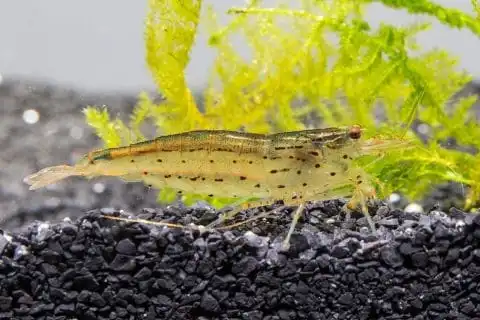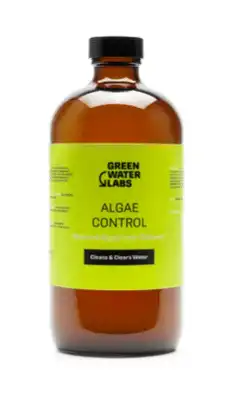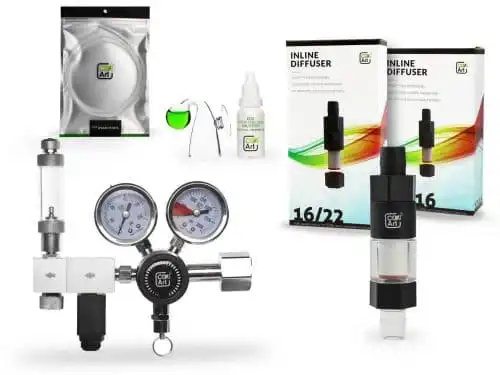Thank you for visiting! By the way… any links on this page that lead to products on Amazon and other stores/partners are affiliate links Aquarium Store Depot earns a commission if you make a purchase.
Black beard algae, three words that strike fear into the heart of aquarists all over the world! Almost all aquarium owners have dealt with BBA at one stage or another. Whether you’re battling an infestation or just looking to avoid it altogether, read this article to learn everything you need to know about black algae in fish tanks.
What Is It?
Audouinella, also known as the black beard or black brush algae (BBA), are stubborn algae species from the red algae family. An infestation of this common fish tank villain looks just like a black or dark green scruffy beard, so it’s pretty obvious where its common name comes from. BBA is quite similar to Staghorn algae in appearance but grows in a denser, darker tuft.
Black beard algae is a natural component of fresh and saltwater environments, so it is not harmful in itself. It doesn’t look great, however, and it can affect plants by blocking out their access to light.
This form of red algae starts out as tiny dark tufts but grows quickly if it isn’t checked early. It attaches itself to plants, rocks, driftwood, aquarium decorations, and even gravel substrate. In other words, this stuff grows almost anywhere!
What Causes BBA?

Black beard algae are usually introduced to your fish tank from other aquariums. This could be on contaminated plants, or pretty much any object from another tank.
Black beard algae reproduce by spores. The algae spores are tiny, so it is easy to spread them in the water that new fish and livestock are delivered in.
There are certain conditions that allow these algae to get out of control, however. Here’s a quick summary of the most common causes of serious black beard algae growth:
- Fluctuating CO2 levels
- Unhealthy Plants
- Too much light
- Excess fish waste and leftover food
- Elevated nitrate and phosphate levels
- Poor filtration and inadequate water circulation
How To Control Black Algae In Fish Tanks
Now that you know more about what black beard algae is, you’re probably itching to know how to get rid of it. Rest assured, that’s what this article is all about, so let’s take a deep dive into some of the best treatment methods!
Biological Control (The Clean-Up Crew)
This is my favorite method of black beard algae control, even if it isn’t the most effective. Why is it my favorite? Because I love algae eaters!
Unfortunately, most animals do not eat black beard algae as their main food source. That means that biological control can be very helpful in the long run, but probably won’t bring fast results.
BBA isn’t the ideal food source for most common aquarium animals, especially if they have access to better food sources like prepared fish food. There are a few species that do eat this type of algae, however, so let’s meet them now!
- Siamese algae eater – Crossocheilus langei
The Siamese algae eater (video source) is probably the most popular choice of fish for controlling black beard algae. Siamese algae eaters grow to about 6 inches in length, so they are a good choice for freshwater aquariums of at least 30 gallons or larger.
- Panda garra – Garra flavatra
Panda garra fish are a great little species that reach a size of about 3.5 inches. These bottom feeding fish are reported to feed on black algae from time to time. They prefer tanks with good water flow and at least 20 gallons of water volume.
- Florida flagfish – Jordanella floridae
The Florida flag fish is a colorful fish species that looks great in tanks of 15 gallons or more. These omnivorous fish feed on a wide range of food sources, including pesky brush algae!
While they won’t completely get rid of black beard algae from your tank, they can do a great job of stopping this algae’s growth.
- Hillstream loach – Sewellia lineolata
The hillstream loach is another awesome algae eater that might help keep black brush algae growth under control. These fascinating algae-eating fish need well-oxygenated, flowing water in tanks that hold 20 gallons or more.
- Molly fish – Poecilia sphenops/ latipinna
It’s a bit of an open secret, but good old mollies can also be great for controlling black beard algae!
It might not be their first choice, however, so don’t be surprised to see them completely ignore the stuff if you feed them a lot of prepared foods like flakes.
Invertebrates:
- Amano shrimp – Caridina japonica
Best For Planted Tanks!
When it comes to keeping a healthy planted aquarium, Amano Shrimp are the best. These hard-working crustaceans will dutifully wipe your plants and rockwork clean of algae. Their appetite for different types of algae that can't be matched by other shrimp breeds!
Fish like the Siamese algae eater aren’t the only animals that can be useful to get rid of black beard algae growth.
Amano shrimps are great little algae-eating inverts that can be kept in tanks as small as 5 gallons. Amano shrimp are especially great for planted tanks!
- Ramshorn snails – Planorbarius duryi
Ramshorn snails are probably the ultimate low-maintenance algae eaters. Unfortunately, these notorious invertebrates tend to find their way into aquariums on live plants and breed out of control. That being said, they are great for cleaning up scraps and generally improving the health of your aquarium.
Care
There’s one last thing to mention before we move on to the most effective methods to remove black beard algae.
Different algae eaters have different care needs, so please make sure your freshwater tank and water parameters will create a healthy environment before bringing any of these species home.
Physical Removal
Sometimes the most obvious solutions are the best solutions. Unfortunately, this is easier said than done when trying to get rid of black beard algae!
If the BBA in your tank is growing on a removable hardscape feature like a rock, or ornament like plastic plants or decorations, scrubbing with a stiff bristle brush or wire brush can be helpful.
Removing black beard algae is safer outside of the tank so that the fragments do not collect in the aquarium water. For any removal in the tank, it is always best to switch off your filter and powerheads to avoid distributing fragments.
If your BBA is growing on aquatic plants, physical removal will be a little more brutal. This stuff is tough, so a quick wipe-down is not going to be much help. Badly affected leaves will need to be removed. Remember to remove these leaves and plant matter from your aquarium.
Black beard algae reproduce by spores, so you’ll probably never remove them all. Physical removal is a great first step toward eradication, but you’ll probably want to proceed directly towards the next treatment methods to finish the job.
Chemical Treatments
Black beard algae often respond very well to chemical treatments. Of course, safety is very important when using chemicals, especially if you keep live plants and animals in your aquarium. Read on to learn two trusted methods!
How To Get Rid of It With Hydrogen Peroxide
Hydrogen peroxide (H2O2) is a compound of hydrogen and oxygen that can be very effective for getting rid of stubborn black beard algae in your aquarium. It is a liquid that is usually available from local drug stores and chemists at a very low cost.
Let’s take a look at some of the ways to use this chemical to treat black beard algae.
Hydrogen peroxide bath
Preparing an H2O2 bath is a great option for plants, ornaments, and hardscape features that you can remove from your tank. You will know you have been successful when the black beard algae begin to turn grey or pinkish.
Dosing hydrogen peroxide
One good method to rid your aquarium of black beard algae is to simply add hydrogen peroxide to the water column. Start by turning off your filter, and your aquarium lighting.
Next, you’ll want to measure out 3 teaspoons of 3% hydrogen peroxide for every ten gallons of water in your aquarium. Add this to the tank and allow it to soak for about an hour before switching the lights and filter back on.
Spot Treatments
You can also apply the hydrogen peroxide directly where you need it using a syringe or a pipette. You can do this under the water, just remember to switch off your filter and lighting.
You can also use this method after draining the tank enough to expose the algae to air, or after removing the affected plant or object from the tank. A small paintbrush can be very useful for applying the hydrogen peroxide, but you can also use a syringe or an eyedropper.
If you are using this method on aquatic plants outside of the water, make sure you rinse the hydrogen peroxide off after 5 minutes at most.
How To Get Rid of It With Liquid Carbon
Liquid carbon is another great chemical treatment for black beard algae. One of the most popular products on the market is Flourish Excel, but there are other products with the same active ingredients too.
Excel is a great way to learn about CO2 dosing before you move on into CO2 injection. It also works great at eliminating problem algae spots!
Liquid carbon can be used with the same techniques as described for hydrogen peroxide. It is not sensitive to light like H2O2, but you’ll still want to turn off your filter.
Many aquarists have had success by going above the recommended dose (overdosing), but this can be very risky for your livestock. If you do choose to go this route, keep a close eye on your pets and be ready to move them or perform a large water change to dilute the concentration.
Spot treatments are generally a safer and more effective method because they allow you to maximize the effect of the liquid carbon where you need it most. If you have a lot of black beard algae in your aquarium, try spot dosing small areas every week, rather than blasting the whole tank at once.
Using Natural Treatments
Another new product to the market is Green Water Labs Algae Control. This product is all natural and safe to use in planted aquariums. It is designed to be used for those using fertilizers and experiencing algae issues such as black beard algae. This formula is also safe to use with snails and shrimp. It has a very straight forward dosing schedule. I would recommend it if you feel uncomfortable going to the CO2 supplement route.
Get Against All Algae!
Using an all-natural treatment, this product inhibits various forms of algae. Safe to use in planted aquariums
Safety Tips
After reading about these (relatively) safe chemical methods of remove black beard algae, it’s worth taking note of the following safety information:
- Remember, black beard algae is mostly a cosmetic issue, so don’t go overboard on treatment at first, you can always try again in a few days!
- Liquid carbon products are not designed for use as algaecides. They can be effective, but using them this way is very much at your own risk.
- Some live plants do not respond well to liquid carbon. Anacharis, Vallisneria, and Japanese moss balls are all sensitive plants that can be negatively affected under high concentrations.
- Liquid carbon is harmful to fish and animals in high concentrations.
- Liquid carbon is toxic to humans and pets, so take precautions when using these products.
Heat Treatment for It in Aquariums
Heat treatment can be a very effective method to remove black beard algae. It does not involve any chemicals, and it’s pretty much free, but there is an obvious downside to this technique.
Heat will also kill your live plants and animals, so it is only really an option for hardscapes and decorations that can be removed from your aquarium. Alternatively, you could also move your plants and animals into another tank temporarily during the process.
You do not need to boil the water, although this will be effective on rocks and driftwood. Plastic ornaments and decorations can melt, however, so use caution.
How To Prevent
Prevention is always better than cure, so it’s really important to avoid this problem from the start. If you’ve already dealt with a black beard algae problem, you’ll also want to prevent it from coming back!
Read this section for a more in-depth look at how to avoid introducing black algae, as well as how to prevent it from growing out of control.
Avoid Introduction
Black beard algae are usually introduced to fish tanks from other aquariums and water sources. Aquatic plants are a very common culprit, so always take the time to inspect and treat new plants before introducing them to your tank.
Sometimes this is not enough, so I always suggest growing tissue culture plants that have been grown under sterile lab conditions. Online retailers like Buceplant stock a great range of these aquatic plants!
Buce Plant offers a wide variety of aquatic plants for sale. With one of the largest selections in the US, you will find what you need here. They are also a great source for freshwater shrimp!
Try not to add any of the water your fish were packaged in by taking the time to slowly acclimate them to your tank water. Never dump a bag full of foreign water into your fish tank! You can totally prevent this way of introduction by properly quarantining your fish.
Maintain Good Water Quality
Black beard algae tend to thrive in poor water quality. High nitrate and phosphate levels in particular are thought to contribute to this problem.
Your first line of defense is regular aquarium maintenance. This means partial water changes at least twice a month and sucking up as much waste with your gravel vacuum as possible. Let’s take a closer look at how to maintain your aquarium to prevent black algae growth.
Your source water could also be a problem. The best way to remove that issue is to either purchase an RO/RODI filter or use distilled water. Whichever you chose, you will need to remineralizer the water with aquarium buffer.
Testing
There’s a lot more going on in our aquariums than meets the eye. Water chemistry is a huge part of maintaining a healthy tank, so you must be able to measure and monitor your water parameters.
A liquid test kit that can monitor phosphate and nitrate levels will be very important in your fight against black beard algae. Knowing what your levels are will help you figure out just how much water you need to change out, and how often you need to do it.
Removing water and waste particles
Decaying waste at the bottom of the tank releases nutrients that feed the brush algae in your aquarium.
Use a gravel vacuum to suck up this waste while you siphon old water out of the tank. Trimming your aquarium plants before a water change is great because you’ll be able to suck out any trimmings that are floating around in the tank.
Filter maintenance
Filter maintenance will not be necessary every time you perform aquarium maintenance.
It is best to follow the manufacturer’s instructions on maintenance regarding your specific model. If your filter sounds different or is not creating as much flow as it should, you might need to rinse out the filtration media.
Remember, the filtration media of a cycled aquarium is home to a thriving population of tiny beneficial bacteria that break down waste in your tank. These little guys should be treated with the care they deserve!
To avoid killing these bacteria, only rinse out your filter media in water that you have just removed from the tank. Tap water that has not been conditioned should not be used.
Adding new water
It’s usually a good idea to prepare new water before you perform a water change to speed up the process. This involves bringing the tap water up to the same temperature as your tank and treating it with a water conditioner to neutralize harmful chemicals.
As I mentioned before, your source water can become a contributor to black algae. Consider getting your city’s tap water report or purchase a TDS meter to see the condition of your water. If your water is high in phosphates and nitrates, it may make sense to switch to distilled or RO water.
Maintain Healthy Plant Growth
For the most part, brush algae do not grow on strong, healthy aquarium plants. The needs of different plants vary depending on their species, but all live plants need good lighting, access to nutrients, and CO2. Providing these in the right balance is the secret to vigorous plant growth.
Black beard algae can grow in a wide range of light conditions, so dimming the lights isn’t necessarily the best option. Providing the minimum amount of light needed to promote healthy plant growth is a good general rule for keeping algae at bay, however. Making sure your plants have sufficient good quality light is a better bet than trying to prevent brush algae growth with low light.
The estimative index (EI) method has proved to be very effective in minimizing this problem in aquarium plants. This method involves fertilizing plants liberally and then performing a large water change every week to ‘reset’ their levels.
This means live plants are never limited in their access to essential macro and micronutrients, but at the same time, you are taking care to prevent these nutrients from building up to dangerous levels.
Even healthy leaves die back when they reach the end of their lifespan, so stay on top of pruning and trimming your aquarium plants. This will promote healthy new regrowth and prevent plant matter from decaying in your fish tank.
Stable CO2 Levels
While increasing CO2 levels may be one of the best ways to achieve healthy plant growth, it is important to keep the levels consistent. Fluctuating CO2 levels appear to favor the growth and development of black beard algae.
Running a pressurized CO2 injection system with good circulation and a drop checker is the best way to avoid inconsistent levels. Calibrate your system to maintain CO2 levels between 20 and 30 ppm to maintain optimum plant growth and keep pesky brush algae to a minimum.
Use Offer Code ASD10%Off
The highest end offering by CO2Art. This package includes everything you need to perform consistent and the highest quality CO2 injection in the industry!
Increasing or stabilizing the carbon dioxide levels in your tank probably won’t kill off the existing brush algae, but it will certainly help to prevent it from growing back after successful treatment.
The combination of proper CO2 usage, fertilizers, and lots of plants will lead to lush plant growth that will choke out nuisance algae like BBA.
Avoid Overstocking and Overfeeding
Black beard algae thrive in high-nutrient environments. Apart from decaying plant matter, the major sources of these nutrients are fish waste and uneaten food.
This is a much bigger problem in tanks that have too many fish, and are given too much food. Increasing your filtration capacity and water change schedule can be very helpful, but it is best to keep your bioload down by stocking and feeding your tank conservatively.
Filtration and Circulation
Adequate filtration is really important for maintaining healthy fish tanks in general. They filter out waste particles and provide a cozy home for the beneficial bacteria that maintain the nitrogen cycle.
It is wise to invest in the best quality filtration your budget allows for, and don’t be shy to run more than one filter on your tank either. Adding some phosphate-absorbing media to your filter is a great way to reduce the phosphate levels in your tank.
We know that fluctuating carbon dioxide levels in the water promote black beard algae, so it makes sense to provide enough circulation to spread this gas evenly through the water column. You can run a small powerhead or wavemaker in your tank if your aquarium filtration system does not create enough water flow.
FAQs
How do I get rid of it in my aquarium?
Controlling black beard algae in your aquarium can be tough. Figuring out the cause of the problem, making some changes, and then killing the algae with careful chemical treatments is the best course of action to solve this problem.
Is It Harmful To Fish?
Black beard algae are not harmful to your fish. Some types of fish, like Siamese algae eaters, will even feed on BBA.
Why does my aquarium have it?
If you have black beard algae in your aquarium, it was probably introduced with live plants or animals from another fish tank. If the conditions are right, these algae can grow and multiply quite quickly.
Do snails eat it?
Some types of snails have been reported to feed on black beard algae. Ramshorn snails in particular can be very effective at controlling black algae. The only downside to these snails is that they have a habit of multiplying fast!
What kills it?
Apart from fish species like the Siamese algae eater that feed on black beard algae, the best way to kill it is to dose or spot treat with hydrogen peroxide or liquid carbon dioxide products like Seachem Excel.
Final Thoughts
In conclusion, black beard algae is a tough but manageable problem that most aquarium owners will face at one time or another. Don’t lose heart if you find this fuzzy growth in your tank, however. Simply follow the steps in this article to beat this nuisance algae in your aquarium and prevent it from coming back!
Have you managed to get rid of black algae in your tanks? Let us know about your experiences in the comments below!
- About the Author
- Latest Posts
I’m thrilled that you found Aquarium Store Depot! Here you’ll find information on fish, aquariums, and all things aquatics related. I’m a hobbyist (being doing this since I was 11) and here to help other hobbyists thrive with their aquariums! I adhere to a high quality Editorial Process and Review products with real life field usage and practical analysis.











How often can I add 3% peroxide to my 20 gal tank,
No live plants
Tropical fish and snails only
Butch Monroe
Dose for 3-4 days in a row then do a 50% water change then you can repeat.
I have no other place to move my fish, than to keep them in the tank. I have BLACK algae, no ‘beard s’, it really likes java fern, it first outlines the edges of the leaves of all the plants, then splotches appear over the leaves. The said algae is not grey like you showed in your pictures, but is night BLACK. Can I dose the tank, 20L gallon, with the fish residing ? There are 2 powder blue dwarf gouramies, 4 glolite rosy tiger barbs and 1 emerald cory ( 2 died ). I’ll be going to a pharmacy in 7 days I’ll pick up H2O2 then, I have API CO2 booster which I can use now. I tried to buy Seachem Excel from Amazon and they won’t ship to California ? Yes I do fertilize the plants, my water is crystal clear, no smell. The lighting is Hagger light strip on 3rd clip down – daylight. Did I give to much info – sorry…………Carol
Hi Carol. What’s your current source water? Have you tested it? It could be high in nitrates or phosphates, which will encourage this growth. If it’s black and slimy this is cyano – which is a telltale sign of high phosphates in your source water.
good ongo